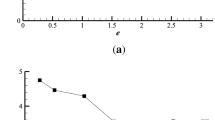Abstract
This study presents a numerical procedure to optimize the cooling passage structure of turbine blade to enhance aerodynamic and heat transfer. Surrogate model based optimization technique is used with Navier-Stokes analysis of fluid flow and heat transfer with RNG k-epsilon transport turbulence model. The objective function is defined as a nonlinear combination of heat transfer and pressure loss with K-S function. Optimal Latin Hypercube Sampling is used to determine the training points as a mean of design of experiment. Two Loops Dynamic Optimization System (TLDOS) is performed to implement the cooling blade optimization. Blade performance improves obviously, especially the kriging model based system. Result shows a significant impact of rib positions for blade heat transfer but slightly for total pressure loss. Numerical simulation proves the feasibility and validity of the TLDOS methods.










Similar content being viewed by others
Abbreviations
- \(x_1^{\it rib}, x_2^{\it rib}\) :
-
Rib relative positions
- X:
-
Vector of design variable
- Xlow :
-
Lower bounds on design variables
- Xup :
-
Upper bounds on design variables
- \(\hat{y}({\bf X})\) :
-
Approximation value of the target function
- r(x):
-
Vector of correlation
- β, θ:
-
Unknown parameters of kriging
- l(θ):
-
Maximum likelihood estimation of θ
- \(\textbf{\textit{R}}\) :
-
n × n correlation matrix
- a i :
-
Constant coefficients of polynomial function
- T i :
-
Inlet total temperature
- P i :
-
Inlet total pressure
- M :
-
Mass flow rate of coolant air
- \(T_{\emph{AVER}}\) :
-
Facet average temperature of blade external wall
- \(T_{\emph{MAX}}\) :
-
Maximum temperature of blade
- \(P_{\emph{LOSS}}\) :
-
Total pressure loss
- f max :
-
Maximum value of vector f(x)
- \(f_{\emph{KS}}(X)\) :
-
KS function
- d:
-
Blade maximal displacement
- σ max :
-
Blade maximal Von Mises stress
References
Bozakaya K, Sumer B, Kuran B et al (2005) Reliability analysis of a solid rocket motor based on response surface method and Monte Carlo simulation. AIAA-2005-3598
De Palma P (2001) Accurate numerical simulation of compressible turbulent flows in turbomachinery. AIAA-2001-2926
Duchaine F, Corpron A, Pons L et al (2009) Development and assessment of a coupled strategy for conjugate heat transfer with large eddy simulation: application to a cooled turbine blade. Int J Heat Fluid Flow 30:1129–1141
Gano SE, Harlod K, Brown DE (2006) Comparison of three surrogate modeling techniques datascape, kriging, and second order regression. AIAA 2006-7048
Janus JM, Newman JC (2000) Aerodynamic and thermal design optimization for turbine airfoils. AIAA-2000-0840
Jin R, Chen W, Sudjianto A (2003) An efficient algorithm for constructing optimal design of computer experiments. ETC-DAC48760. In: ASME design automation conference, Chicago
Jun S, Jeon Yh, Rho J et al (2004) Application of collaborative optimization using response surface methodology to an aircraft wing design. AIAA 2004-4442
Kim K-Y, Shin D-Y (2008) Optimization of a staggered dimpled surface in a cooling channel using Kring model. Int J Therm Sci 47:1464–1472
Krishnamurthy T (2005) Comparison of response surface construction methods for derivative estimation using moving least squares, kriging and radial basis functions. AIAA 2005-1821
Kumano T, Jeong S, Obayashi S (2006) Multidisciplinary design optimization of wing shape for a small jet aircraft using kriging model. AIAA 2006-932
Kuran B, Hasanoglu MS, Bozkaya K (2007) Robust design optimization for multiple response using response surface methodology and Taguchi approach: solid rocket motor application. AIAA-2007-1977
Martin JD (2006) A Monte Carlo method for reliability-based design optimization. AIAA 2006-2146
Pierret S, Filomeno R, Kato CH (2007) Multidisciplinary and multiple operating points shape optimization of three-dimensional compressor blades. Struct Multidisc Optim 33:61–70
Pretorius CA, Craig KJ (2004) Kriging response surfaces as an alternative implementation of RBDO in continuous casting design optimization. AIAA 2004-4519
Sethi SS, Striz AG (1997) On using the Kreisselmeier-Steinhauser function in simultaneous analysis and design. AIAA-1997-1289
Shyy W, Papila N, Vaidyanathan R et al (2001) Global design optimization for aerodynamics and rocket propulsion components. Prog Aerosp Sci 37:59–118
Sobieszczanski-Sobieski J (1992) A technique for locating function roots and for satisfuing equality constraints in optimization. Struct Optim 4:241–243
Wang D, Naterer GF, Wang G (2002) Adaptive response surface method for thermal optimization: application to aircraft engine cooling system. AIAA 2002-3000
Venter G, Haftka RT (1997) Response surface approximations for fatigue life prediction. AIAA-1997-1331
Vervenne K, Fatemi J, van Keulen F (2004) Efficiency improvement of response surface building using fast reanalysis methods. AIAA 2004-1874
Yu K, Yue Z (2007) Parametric design for cooling turbine blades based on analytic and feature modeling. China J Propul Technol 28(6):637–640
Acknowledgments
The work was supported by Doctoral Research Fund of Henan University of Science and Technology, the fund of the State Key Laboratory of Solidification Processing in Northwestern Polytechnical University (SKLSP201008) and China National High-tech Research and Development Program (No. 2009AA04Z418).
Author information
Authors and Affiliations
Corresponding author
Rights and permissions
About this article
Cite this article
Yu, K., Yang, X. & Yue, Z. Aerodynamic and heat transfer design optimization of internally cooling turbine blade based different surrogate models. Struct Multidisc Optim 44, 75–83 (2011). https://doi.org/10.1007/s00158-010-0583-x
Received:
Revised:
Accepted:
Published:
Issue Date:
DOI: https://doi.org/10.1007/s00158-010-0583-x



